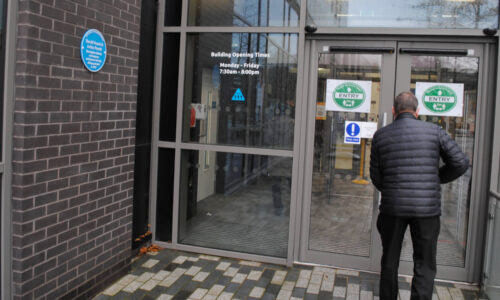By making it easier to enter and exit a building, automatic doors help to improve accessibility for everyone. Automatic doors can be opened without manually pushing or pulling a heavy door, allowing all users of a building to enjoy safe and easy access.
How Do Automatic Doors Work?
Automatic doors use a sensor to detect when the door needs to open. The sensor sends a signal to the door operating mechanism, which then opens the door. This can work in one of four ways;
- Motion detection sensors: Automatic doors fitted with microwave beam motion detectors or passive infrared (PIR) sensors detect movement, triggering the door to open when a person approaches.
- Pressure sensors: A mat or pad on the ground in front of the door detects a change in pressure when a person steps onto it, causing the door to open automatically.
- Access control system: Using a signal from a keycard, fob, smartphone, or other device, the door only opens to those with authorised access. An automatic door can also be controlled via a smart video intercom which allows visitors to be verified before entry is granted.
- Automatic door openers: Push or touch to open buttons can be used to make an entrance more accessible to all users.
What Are Different Types of Automatic Doors?
There are two key types of automatic door: sliding and swing. Both are commonly used to improve accessibility in a variety of public and commercial settings, including shops, schools, and hospitals.
- Sliding automatic doors: The doors slide neatly to the side when open. This solution works well where there is limited space in front of the doorway, as the door doesn’t need to swing into the room.
- Swing automatic doors: The doors swing to open, typically swinging inward into the building. These doors can be easier to operate manually if required.
What Are the Benefits of Automatic Doors?
Automatic doors have many advantages over manual doors, including;
- Accessibility: A building can be accessed without pushing or pulling a door, making entry safer and easier for all users.
- Energy efficiency: Doors which close automatically after use can help prevent heat loss, which in turn improves energy efficiency.
- Convenience: When approaching the doorway while pushing a trolley or carrying a heavy load, there is no need to have a hand free to open the door.
- Hygiene-friendly: Users can enter and exit a building without touching door handles or push plates, preventing the spread of germs in busy areas.
Can I Choose How Long Automatic Doors Stay Open?
The time that automatic doors stay open can be adjusted to suit each individual entrance. Automatic doors should remain open for 2 to 3 seconds to allow users to safely pass through the doorway before it begins to close, however an automatic door sensor should prevent the door closing if it detects something in its path.
Are Automatic Doors Safe?
Automatic doors can be safer than manual doors, as there is no need to push or pull a heavy door, which can be difficult for those with limited mobility. Automatic doors are also fitted with safety sensors which detect an obstruction on the door track and prevent the door closing if there is a person or object blocking the doorway.
Can Manual Doors Be Automated?
It is often possible to automate an existing set of manual doors to improve accessibility, energy efficiency, and convenience. A number of factors will affect whether a manual door can be converted into an automatic door, including;
- Door construction
- Door hardware
- Locking mechanism
- Nearby power source
- Space for mounting automatic door operator
How Long Does an Automatic Door Last?
Automatic doors generally undergo less wear and tear than a manual door, as it is impossible for the door to be slammed or forced, and the door will always open at a controlled speed. However, routine servicing will ensure that an automatic door will have a longer lifespan and continue to work safely and reliably for up to 20 years.
How Often Should Automatic Doors Be Serviced?
To comply with BSEN16005 and BS7036 2014, automatic doors should be serviced at least once a year and a risk assessment document issued. To prevent faults, most maintenance contracts include a service twice a year. The door manufacturer may also specify if parts need to be replaced after a certain number of uses.
Upgrade To Automatic Doors with Access Control Solutions
Installing automatic doors for a variety of commercial clients, Access Control Solutions specialises in making every building secure and accessible. To enquire about upgrading to automatic doors, call 0116 236 6044 or complete our contact form to get in touch.
Posted in Automatic Doors
